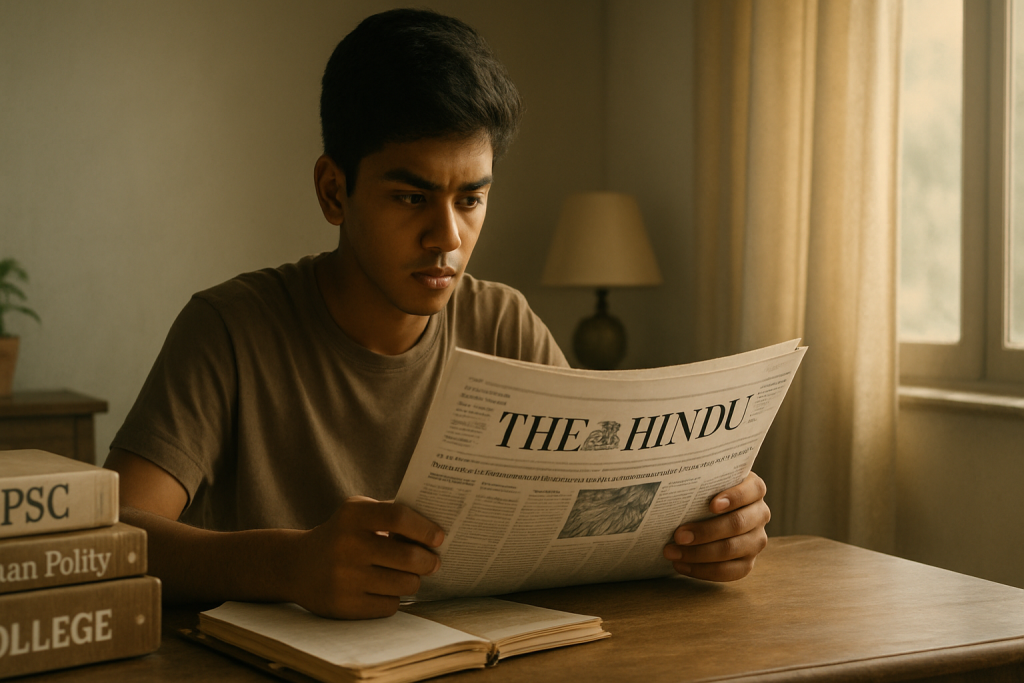No products in the cart.
Starting UPSC Prep at 17: Discipline, Degrees, and the Fine Line Between Ambition and Burnout
India’s teenagers are beginning UPSC prep years before they’re eligible. Experts and toppers say the trick is balance—board grades, degree depth, answer-writing practice, and a live Plan B.
Seventeen-year-old Anushka Banerjee starts her day under a streetlight-dim dawn, scrolling through The Hindu’s editorial page at 5 a.m. before turning to rotational dynamics for her Class-12 physics practical. “Once school ends, IAS notes begin,” she says, voicing a now-familiar mantra among teenagers who begin preparing for the Union Public Service Commission (UPSC) exam years before they can legally take it at 21. The allure is obvious: in 2024, just 0.2 percent of the 1 million-plus candidates cleared the test, a ratio of roughly one success in 500 tries.
That statistical choke point fuels the early-start movement but also raises tougher questions. How early is productive? Which degree path sustains momentum? Can a 17-year-old juggle board marks, graduation demands, and civil-service prep without courting burnout—or ignoring a Plan B? Below, a reported 1,100-word roadmap drawn from official data, coaching-school audits, and interviews with toppers and psychologists.
The Four-Year Funnel
UPSC rules permit six attempts for General-category candidates between ages 21 and 32. Starting at 17 delivers a four-year runway for fundamentals while still leaving room for every permitted attempt, even if the first two or three misfire.
Educational psychologist Dr. Smita Gautam notes that “adolescent brains encode languages and social-science frameworks faster than those in the late twenties,” but warns that the edge flips into fatigue without guardrails. Her prescription: two disciplined hours on NCERT texts during Class 12, not premature mock-test marathons.
Do:
Anchor on NCERT Class 6–12 history, geography, and polity, the spine of General Studies I.
- Anchor on NCERT Class 6–12 history, geography, and polity, the spine of General Studies I.
- Allocate 30 minutes of quality news—The Hindu, Indian Express, PIB briefs—to cultivate current-affairs reflexes.
Don’t:
- Buy full test-series until you can condense an NCERT chapter into a 200-word summary; otherwise you rehearse questions you do not yet understand.
Choosing the Right Degree
A 2024 audit of 1,095 finalists by K3 IAS showed that 61 percent held humanities or social-science degrees; engineers made up 23 percent, with natural-science majors comprising the balance. The figures feed a parental myth that only humanities “fit” UPSC, yet toppers push back. Tina Dabi, a political-science graduate who topped in 2015, and engineer Srushti Deshmukh, who ranked fifth in 2018, both cite sustained engagement—not syllabus overlap—as decisive factors.
As Dabi puts it, “You clear because you stay engaged, not because your syllabus matches perfectly”.
Guideline: Choose a degree you can enjoy for three years and maintain a strong GPA in. Dropping grades derails final-year momentum far more often than choosing the “wrong” subject.
Board Exams Still Come First
Even the most ambitious starter confronts an immediate gatekeeper: Class-12 boards. Interviews with recent All-India Rankers show a near-unanimous rule—October through March is reserved for schoolwork; UPSC prep slips into evenings and vacation breaks.
Khushboo Gupta (AIR 6, 2023) carved out “20-minute current-affair bursts on the bus” and deployed winter holidays to redraw medieval-India timelines. She also follows the “one-source rule,” reading Laxmikanth’s Indian Polity multiple times instead of chasing new guidebooks each semester.
Khushboo Gupta (AIR 6, 2023) carved out “20-minute current-affair bursts on the bus” and deployed winter holidays to redraw medieval-India timelines.
Takeaway: Board essays double as rehearsal for UPSC’s analytical prose, but full-time coaching in Class 12 consistently sinks both goals.

The Odds and the Plan B
With sub-1 percent odds, a parallel runway is not defeatism; it is survival strategy. The syllabus overlap between UPSC General Studies and other public-sector exams is wide:
| Backup Exam | Syllabus Overlap | Age Window |
|---|---|---|
| State PCS (e.g., UPPCS) | ≈70 percent of GS content | 21–40 |
| SSC CGL | Polity, Economy basics | 18–32 |
| RBI Grade B | Macroeconomics (GS-III) | 21–30 |
| EPFO EO/AO | Polity, Labour law | 21–30 |
Smart move: log every backup syllabus in a spreadsheet by second-year college; highlight common topics for synergy so revision for one exam reinforces another. Waiting until “someday” is the surest way to let Plan B vanish.
A Practical Timeline (17 – 21)
- Class 12 (17-18 y):
- Finish one pass of all NCERTs.
- Compile a 200-page current-affairs notebook.
- First Year of College:
- Second Year:
- Third Year:
- Final Year / Post-Grad:
The Mental-Health Equation
Most coaching houses peg focused UPSC prep at 10–12 months after basics are done. The risk for early starters is overextension. Psychiatrist-turned-IAS Dr. Lakshmikant Sharma tracks a burnout spike around the 20-month mark and recommends the “3-2-1 rule”: three concentrated study blocks per day, two social interactions per week, one hobby day per month.
Sleep is non-negotiable. Reviews of cognitive research link sub-six-hour sleep to impaired memory consolidation, undermining the very edge early starters seek.
Shankar of K3 IAS underscores the data: students who submit essay drafts by second year average 15-point higher mains scores in his sample of 400 candidates.
Lessons from the Front Line
“Starting early lets you fail on paper before you fail on stage,” says Athar Aamir Khan (AIR 2, 2015), who began current-affairs notes in his second engineering semester. Tina Dabi adds that early answer-writing “bridges the gap between knowing and explaining,” the chasm where many bright candidates stumble. K.S. Shankar of K3 IAS underscores the data: students who submit essay drafts by second year average 15-point higher mains scores in his sample of 400 candidates.
Money, Gender, and Digital Discipline
- Cost. A year of classroom coaching in Delhi now tops ₹2 lakh, excluding rent and test-series fees. Online platforms like Sleepyclasses lower the bill to one-fifth, but families must still budget for national mock tests and annual current-affair digests.
- Gender. Women now make up about 30 percent of the UPSC final list, up from 18 percent a decade ago. Early starts can give female aspirants more attempts within the “safety” bracket before marital or caregiving expectations intrude, mentors say.
- Digital discipline. Generation-Z prep collides with algorithmic distraction. A Testbook survey found candidates who capped entertainment-app use at 30 minutes daily scored 12 percent higher in prelim mocks. Experts advise curated Telegram channels and browser extensions that block feed loops during study blocks.
What It All Adds Up To
Beginning UPSC preparation at 17 can be a cushion or a trap. The cushion: extra time to master fundamentals, tolerance for trial-and-error, and six clean attempts. The trap: burnout, tanked board marks, or a single-track dream with no fallback. The balance lies in disciplined duality—pick a degree you love, guard your school performance, weave UPSC habits into digestible slices, and keep Plan B moving in parallel. Civil-service ambition should widen horizons, not narrow them. For the teenager with a physics notebook in one hand and polity flashcards in the other, the real question is no longer how early to start, but how wisely.











